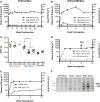Robust ZFN-mediated genome editing in adult hemophilic mice
- PMID: 24085764
- PMCID: PMC3821724
- DOI: 10.1182/blood-2013-04-497354
Robust ZFN-mediated genome editing in adult hemophilic mice
Abstract
Monogenic diseases, including hemophilia, represent ideal targets for genome-editing approaches aimed at correcting a defective gene. Here we report that systemic adeno-associated virus (AAV) vector delivery of zinc finger nucleases (ZFNs) and corrective donor template to the predominantly quiescent livers of adult mice enables production of high levels of human factor IX in a murine model of hemophilia B. Further, we show that off-target cleavage can be substantially reduced while maintaining robust editing by using obligate heterodimeric ZFNs engineered to minimize unwanted cleavage attributable to homodimerization of the ZFNs. These results broaden the therapeutic potential of AAV/ZFN-mediated genome editing in the liver and could expand this strategy to other nonreplicating cell types.
Figures


References
Publication types
MeSH terms
Substances
Grants and funding
LinkOut - more resources
Full Text Sources
Other Literature Sources
Medical
Molecular Biology Databases

